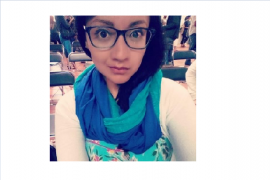Women from TRYMéxico occupying public space as part of the activities of the feminist movement in Mexico
31 May 2022In Mexico City, since 2011 and uninterruptedly until 2022, on March 8, diverse groups of women and feminists meet to take to the streets, collectively commemorate and raise our voices in favor of our rights. Women had marched before shouting “Women are not collateral damages of war!”, speaking out against the militarization of the country, sexual violence and impunity (Atenco was fresh in our collective memory[1]). However, it was after 2011 when the taking of the streets was instituted to vindicate our rights and demand lives free of violence. Since then, our slogans have resounded in on Reforma Avenue, the Angel of Independence, the Monument to the Revolution, the Ministry of the Interior, the Hemicycle to Juarez, the Monument to the Mother and the Zócalo of Mexico City.
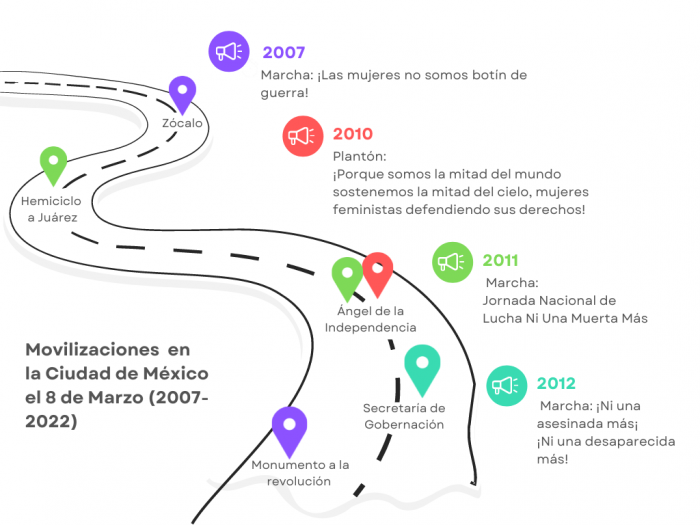
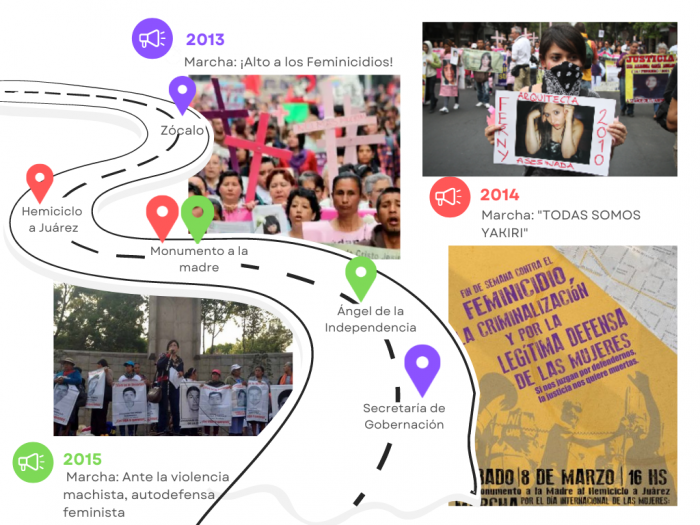
Since 2017, feminist demands have been increasingly echoed. Women’s collectives, feminist groups, social organizations and many more women, denounced in the streets and digital space, the crude situation we face in Mexico through performances, songs, paintings, graffiti, forums, galleries, among many other activities.[2] As a result of this hard-fought, necessary and festive struggle, in 2019 the Antimonumenta[3] was installed on Juarez Avenue and in 2020 we marched more than 80,000 women in Mexico City and successfully developed the day “A Day Without Us”, the result of the International Women’s Strike on March 9, with the slogan “On the ninth no one moves”. In 2021, despite the pandemic, more than 20,000 women mobilized in the streets and the digital space was dyed purple (color symbolizing feminism) and green (color representing the struggles for the legalization of abortion) to amplify the echo of feminist demands and struggles. The marches around 8M mobilize the strength of women’s demands and commemorate the feminist struggles that have accompanied Mexico in the 21st century. Our voices continue to shout “Feminicidal state!” and “We want us alive, free and without fear. Not one less!”.
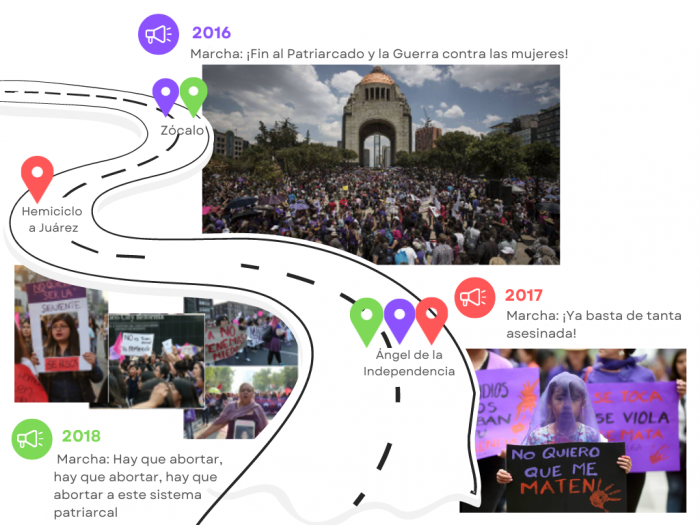
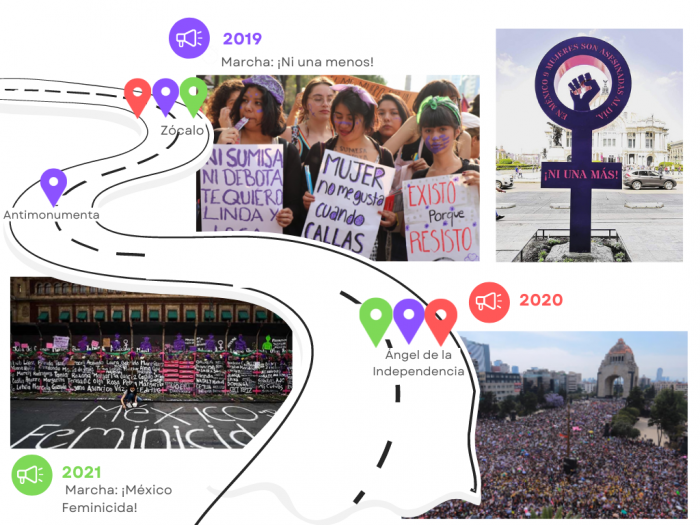
The role of female university students has been fundamental. In recent years, female students have led important mobilizations (including takeovers of some faculties) to make visible the violence experienced by women, to demand sanctions for the aggressors and justice for the victims.
On March 8 of this year, we took to the streets again and the walls installed by the government to encircle us were unable to contain us[4]. We were an unstoppable tide of more than 85,000 people – cis women, trans people, non-binary subjectivities. From very early in the morning and until nightfall, we met, we accompanied each other and together we empowered our voices, paintings, performances and reflections for mutual care. With rage, the powerful rage of feminisms in the street, we rejected macho violence, the disappearance of our comrades, exploitation and fear. We were together and once again the streets were dyed purple and rumbled with our voices “Not one more!”, “We want us alive!”, “My body is mine, I decide, I have autonomy, I am mine, no, I told you no, asshole no!”
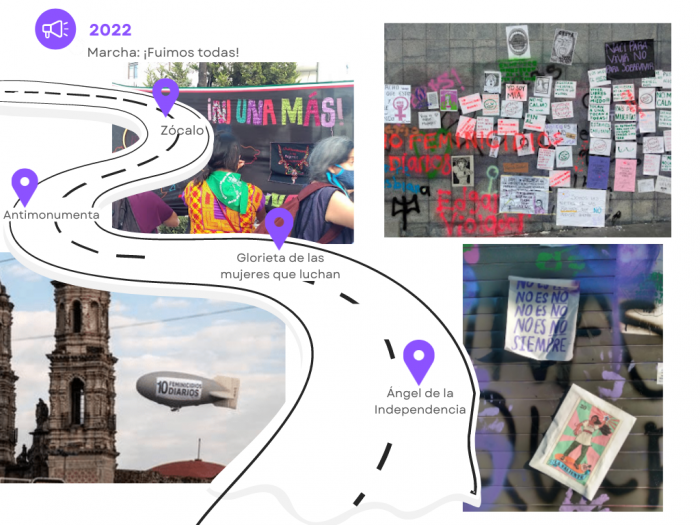
On that day, the Antimonumentas were points of congregation, stopping and struggle. In particular, the “Traffic circle of women who struggle” was a place of memory, contact and respect during the march. In this anti-monument, where the statue of Christopher Columbus used to stand, a purple woman representing missing or murdered women and demanding justice was installed this year; there also hung a clothesline of denunciations and protests that was built since March 5 from the #Yodenunciépero, #Yodenunciéporque and #Somostodas.
We were together, yes, but the “together” does not homogenize us, we transcend the institutionalized ideal of THE WOMAN promoted by the UN. The debates between the separatist movement and comrades who do not recognize themselves as women -because they transgress the dichotomy of the sex-gender and heteronormative system- were also visible on 8M in slogans, graffiti, contingents, harangues and colors of the flags. The demands of those who are not portrayed in the media, trans women, migrant women, Black women, Indigenous women, women with other abilities, houseless women, also left their mark on the streets on 8M.
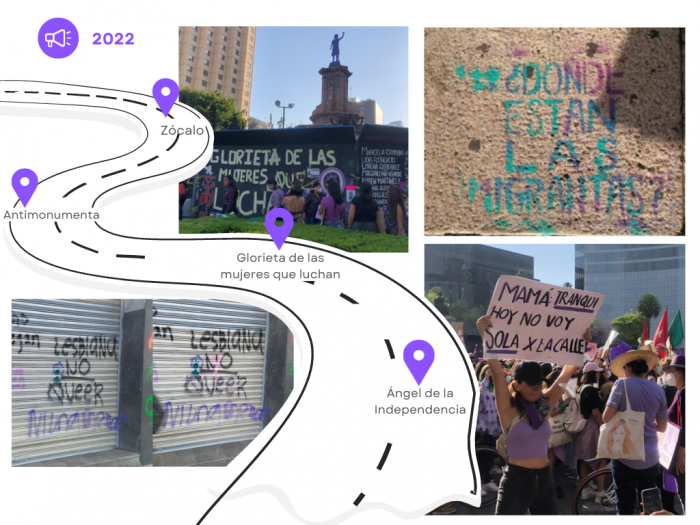
Reflections and protests were not limited to the street. In a powerful meeting on “Houseless Women”, held at the Center for Complexity Sciences of the UNAM, as part of the talk series “Spaces for dialogue, respect and understanding,” the experience of houseless women was discussed. The panel was formed by Dr. Alí Ruiz Coronel, Researcher at the Institute of Social Research (IIS-UNAM), expert in street population; Laura Díaz, Medical Lieutenant who works in brigades of attention in vulnerable populations; Victoria Sámano, Director of LLECA Escuchando la calle, a collective and shelter that supports houseless trans women sex workers, and Lorena Paredes, co-founder of Psicocalle Colectivo and TRYSPACES student. (See https://www.facebook.com/C3.unam/videos/677841793651480)
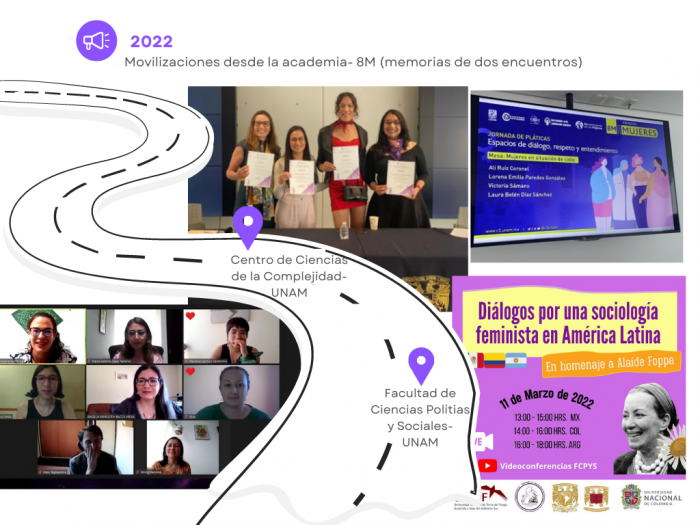
Also, at the Faculty of Political and Social Sciences of the UNAM, the meeting “Dialogues for a feminist sociology in Latin America. In homage to Alaíde Foppa”, with the participation of students and professors from three countries: from Colombia, Yenny Carolina Ramírez and María Salomé Daza; from Argentina, Eliana Debbia and Maximiliano Tagliapietra; and from Mexico, Selene Aldana Santana, Mariana García Crisóstomo and Ángela Margoth Bacca, TRYSPACES researcher. The event paid tribute to the work of female authors who have contributed to sociological theory and sought to discuss different initiatives to question the androcentric canon present in Latin American academia and build feminist paths to achieve its transformation from the classroom. (See https://www.youtube.com/watch?v=x4SO7KfXsBI&t=10s)
More than 450 activities have been organized in the UNAM (the main public university in the country). (https://drive.google.com/file/d/1-qwrKuMc54RFtD1KIyFHYQSsat4p8WSJ/view), including lectures, discussions, movie projections, roundtables, with the participation of academics, students and collectives. Likewise, the Coordination for Gender Equality (CIGU – UNAM) has posted on its platform materials for the men who make up the community (academics, students, administrative staff), which allow them to think about their role in the framework of these commemorations and, in general, to achieve non-violence. The university accompanied the March 8 mobilizations, as well as the call for “A day without women” on March 9, inviting the men of the community to maintain their daily activities and reflect on the meaning of the absence of women from common spaces.
The multiple activities related to 8M extend throughout the month of March and are an example of the life of the feminist and women’s movements in Mexico. It is this enormous tide that has managed to disrupt the institutional meanings of the 8M promoted by governments and multilateral organizations; to recover the history of the commemorations of socialist women workers in the early twentieth century; to position in the public debate the denunciations and demands against the acute violence that women face; and to build from the street to the academy spaces of expression and debate for a world free of violence, feminist and just.
[1] On May 3 and 4, 2006, in the municipality of Atenco, not so far from Mexico City, neighbors and activists protested against the construction of the new Mexico City international airport in their territories. The government of the State of Mexico carried out a repressive military operation, committing serious human rights violations. In 2018, the Inter-American Court of Human Rights sentenced the Mexican State as responsible for physical, sexual and psychological torture of 11 women detained without justification in the midst of protests.
[2] In 2021, 2,747 women were murdered in Mexico, that is, around 10 women daily. Of these crimes, only 27% were classified as femicide and impunity is estimated to be around 95%. In addition, there were 253,736 reports of domestic violence and 21,188 reports of rape (a 20% increase over the previous two years). Likewise, during the pandemic, wage gaps and women’s vulnerabilities worsened, given the burden of economic-reproductive and health activities that fell on them, the high level of informality and women’s unemployment. See the report of the Executive Secretariat of the National Public Security System of January 2022 https://drive.google.com/file/d/1NBXVxuDczwaL2XVf4l0br8HL0JlBvbTz/view
[3] In Mexico, anti-monuments are self-managed symbolic works installed in public spaces to transgress social and state oblivion and denounce impunity in emblematic cases of violence, disasters and state crimes. The anti-monuments in Mexico City, and in other parts of the country such as Nezahualcóyotl, Jalisco and Chiapas, have been promoted by relatives of victims of femicides and feminist collectives, and symbolize the demand for justice for the thousands of victims of gender violence and femicides.
[4] Since 2020, the Mexico City government has placed metal sheets to “protect” monuments and government buildings, arguing that feminist interventions on their walls undermine their cultural and conservation value. Disputes about the changing character of monuments have been an element of debate by several feminist collectives @RestauradorasconGlitter, @antimonumenta.










